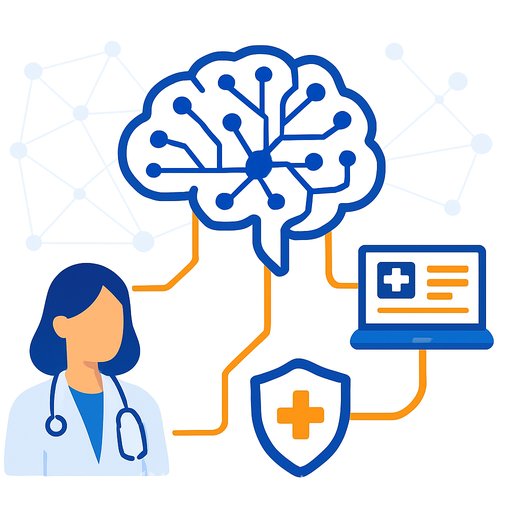Artificial Intelligence In Healthcare 101: Infrastructure Decides Outcomes
AI gets the headlines, but infrastructure decides whether it works in the real world. Without secure, high-speed, low-latency networks, even the best models stall at the bedside and in the back office. That's the core message echoed by leaders building the networks hospitals run on, including Greg Dorai of Cisco.
Think of AI as the brain and the network as the nervous system. Intelligence only matters if it moves to the right place, at the right time, with the right access.
Where AI Is Delivering Value Now
Clinically, AI supports earlier detection and more precise decisions. Hospitals use predictive models to anticipate bed occupancy and smooth patient flow. In breast cancer screening, AI has improved detection rates without raising false positives.
Operations and research benefit too. Generative AI reduces documentation time, while predictive tools strengthen staffing and supply planning. Drug discovery and clinical trial matching are accelerating. The limiter isn't ideas. It's throughput, latency, and trust.
The Risk Profile Is Expanding
Bias remains a real threat. Models trained on narrow datasets can miss signals in broader populations and create unequal outcomes. Tools that perform well in pilots can add friction once they hit live workflows.
Cybersecurity is the biggest concern. Healthcare carries sensitive data, runs on connected devices, and spans hospitals, clinics, and homes. As AI touches more nodes, the attack surface grows. Networks must decide, in real time, who or what can connect, what they can access, and for how long-without adding operational drag.
Patient Experience: Faster, More Connected Care
AI can flag disease earlier, tailor treatments, and shorten the path to answers. Remote monitoring shows the point: a wearable can catch an arrhythmia and alert a care team in time to act. It only works if the alert reaches the right clinician instantly and securely.
As care stretches from hospitals to clinics, campuses, and homes, trusted connectivity is the foundation. No signal, no insight. No insight, no intervention.
Workforce Experience: Less Busywork, Better Decisions
AI scribes cut note-taking. Predictive staffing tools reduce last-minute churn. Simulation and training tech raise skills for complex procedures.
The challenge is scale. To make these wins standard everywhere-from ORs to home health-organizations need networks that handle high-compute, low-latency workloads consistently and safely.
What "AI-Ready" Infrastructure Looks Like
- Throughput and latency that match clinical need: Wired and wireless with quality of service for imaging, voice, and real-time inference.
- Edge compute near care: GPUs/accelerators close to imaging suites, labs, and monitoring hubs to cut round trips.
- Identity-based access and segmentation: Least privilege for users, devices, apps, and workloads across hospital, clinic, and home.
- End-to-end observability: Telemetry, anomaly detection, and AIOps to spot drift, bottlenecks, and threats before they hit patients.
- Data security and governance: Encryption in motion and at rest, key management, de-identification where possible, and PHI handling policies.
- Standards and interoperability: FHIR APIs and event-driven integration so AI outputs flow into EHRs and clinician tools without rework.
- Resilience: Redundant paths, automatic failover, and clear runbooks so clinical services keep running during incidents.
- Model monitoring: Performance, bias, and drift monitoring tied to incident response and change control.
Practical Steps For Leaders
For CIOs/CTOs and Network Leaders
- Baseline current capacity and latency across sites. Map AI workloads (imaging, scribing, prediction, monitoring) and run capacity plans for peak demand.
- Enforce least-privilege access with identity-based segmentation for users, devices, and services. Prefer certificate-based auth over shared credentials.
- Place edge nodes where milliseconds matter (radiology, ORs, ICUs, telemetry). Cache models locally and sync centrally on a schedule.
- Integrate MLOps with SecOps. Every model change goes through threat modeling, privacy review, and rollback planning.
- Run tabletop exercises for cyber events that hit AI services. Define recovery time and data loss tolerances for each use case.
For Clinical and Operations Leaders
- Prioritize a few high-impact use cases (e.g., sepsis alerts, imaging triage, capacity prediction). Co-design workflows. Add clear fail-safes and escalation paths.
- Adopt human-in-the-loop policies. AI suggests, clinicians decide. Track overrides to improve models and workflows.
- Measure outcomes and equity. Report performance by demographic subgroup. Adjust datasets and thresholds to close gaps.
For Developers and Data Science Teams
- Version data and models. Log features, hyperparameters, and lineage. Automate reproducible training and evaluation.
- Run bias and drift checks in production. Use canary releases for new models and set circuit breakers for degraded performance.
- Use privacy-preserving methods where possible (federated learning, differential privacy) and align with the NIST AI Risk Management Framework.
- For regulated use cases, follow the FDA's guidance on AI/ML-enabled medical devices and documentation expectations: FDA AI/ML in SaMD.
The Bottom Line
AI can improve diagnosis, efficiency, and training-but only if the network moves intelligence securely and instantly to the point of care. The organizations that treat connectivity as clinical infrastructure will deliver care that is faster, fairer, and more connected.
If you need to upskill teams across roles for AI projects in healthcare, explore concise learning paths by job at Complete AI Training.
Your membership also unlocks:










